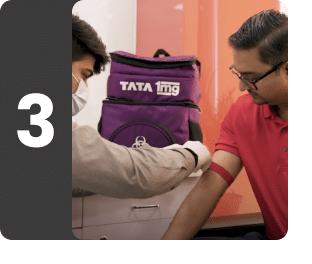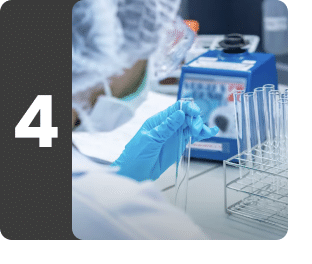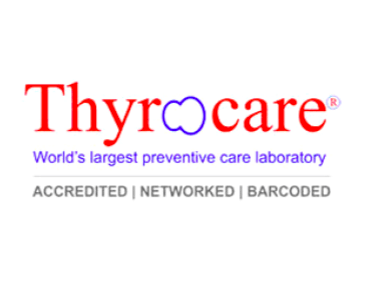

Aarogyam 1.8 With UTSH near me in Bangalore
Understanding Aarogyam 1.8 With UTSH in Bangalore
What is Aarogyam 1.8 With UTSH in Bangalore?
Aarogyam 1.8 with ultrasensitive thyroid stimulating hormone (UTSH) is a comprehensive package tailored to evaluate your overall health. This package offers a set of blood tests such as kidney function test with electrolytes, liver function test, lipid profile, iron profile, complete vitamin profile including vitamin A, blood sugar tests, fructosamine test, thyroid stimulating hormone-ultrasensitive (UTSH) test, triiodothyronine total (T3) test, thyroxine total (T4) test, mineral test (copper and zinc), enzyme test (lipase and amylase), protein test (cystatin and homocysteine), testosterone total test, cardiac risk markers, lipoprotein PLA2 test, and toxic elements 22 test. This package helps in the early detection of potential health problems so that timely treatment can be started to avoid disease progression and subsequent complications.
What does Aarogyam 1.8 With UTSH measure?
Contains 83 testsLp-PLA2 (LIPOPROTEIN ASSOCIATED PHOSPHOLIPASE A2), ACTIVITY
Vitamin A (Retinol) Test

Triiodothyronine Total
A Triiodothyronine Total measures triiodothyronine, also known as T3, hormone that is produced by the thyroid gland. T3 hormone plays an important role in regulating the body's metabolism, energy levels, and growth & development. It exists in the blood in two forms: free T3 and bound T3. Free T3 is not bound to proteins in the blood and is the active form of T3. Whereas, bound T3 is bound to proteins, such as albumin and thyroid hormone binding globulin (THBG), which prevent it from entering the body tissues.
Know more about Triiodothyronine Total

Insulin Fasting
An Insulin Fasting test evaluates the amount of insulin available in your blood following a fasting period of about 8-12 hours, which helps in regulating glucose levels.
Glucose is a source of energy for the body to perform daily activities. Your body gets glucose from carbohydrates that are consumed in the diet. These carbohydrates are digested and converted into simple sugar (glucose). The required amount of glucose is then absorbed by the cells for the production of energy, and the remaining amount is stored in other forms like fats. Insulin hormone helps the cells to uptake glucose from the blood for utilization and storage. Thus, it is necessary to maintain insulin levels in your body.
Know more about Insulin Fasting
Vitamin B7

TSH (Thyroid Stimulating Hormone) Ultrasensitive
A TSH (Thyroid Stimulating Hormone) Ultrasensitive test measures the levels of TSH hormone in the blood. TSH is produced by the pituitary gland located in the brain. Its function is to stimulate and regulate the functioning of the thyroid gland. It signals the thyroid gland to increase or decrease the production of thyroid hormones T3 and T4 (essential for regulating our body’s metabolism, temperature, heart rate, and growth) when their levels are low or high, respectively. Therefore, when the levels of T3 & T4 decrease, the pituitary gland is stimulated to release TSH. This high TSH level in turn stimulates the thyroid gland to release more thyroid hormones (T3 & T4); the vice-versa happens when the levels of thyroid hormones increase.
Know more about TSH (Thyroid Stimulating Hormone) Ultrasensitive
Zinc, Serum
Vitamin B6

Sodium
A Sodium test is used to measure the amount of sodium in your body. Sodium is present in all body fluids and is found in the highest concentration in the extracellular fluid. The body absorbs the required amount of sodium through dietary salts and the remaining is eliminated through the kidneys. The body keeps your blood sodium within a normal and steady range by following three mechanisms:
-
By producing hormones that control the elimination of sodium through urine, such as natriuretic peptides and aldosterone.
-
By producing hormones that prevent water loss, such as antidiuretic hormone (ADH) or vasopressin.
-
By controlling thirst (an increase in blood sodium level can make you thirsty and cause you to drink water, returning your sodium to normal).
These mechanisms regulate the amount of water and sodium in the body and control blood pressure by keeping the amount of water in check. When the level of sodium in the blood changes, the water content in your body changes. These changes can be associated with dehydration, edema, and change in blood pressure.
Know more about Sodium

Testosterone Total
A Testosterone Total test measures the level of testosterone hormone in the blood. Testosterone is a sex hormone that is mainly found in men but is also present in women in small amounts. The appearance of male physical characteristics is also due to this hormone.
The production of testosterone hormone is regulated by luteinizing hormone (LH), which is produced by the pituitary gland. As the levels of testosterone rise, the production of LH decreases which in turn slows down the production of testosterone. Similarly, when the levels of testosterone fall, it leads to an increase in LH production, which in turn stimulates testosterone production.
Most of the testosterone circulating in the blood gets attached to two proteins: albumin and sex hormone-binding globulin (SHBG), and some of it remains unattached which is called free testosterone. Free testosterone and albumin-bound testosterone are also known as bioavailable testosterone as they are easily available for the body to use for proper functioning.
Know more about Testosterone Total

Chloride
A Chloride test measures the amount of chloride in your body. Chloride is present in all body fluids and is found in the highest concentration in the blood and extracellular fluid (fluid present outside the cells). The body gets most of the chloride through dietary salt (sodium chloride or NaCl) and a small amount through other food items. The required amount of chloride is absorbed in the body and the excess amount is excreted by the kidneys through urine. When the chloride is combined with sodium it is mostly found in nature as salt. Chloride generally increases or decreases in direct relationship to sodium but may also change without any changes in sodium levels when there are problems with the body's pH. Usually, the normal blood chloride level remains steady with a slight fall after meals (because the stomach produces hydrochloric acid using chloride from the blood after we eat food).
Know more about Chloride
Serum Homocysteine

Kidney Profile
Uric Acid
A Uric Acid test determines the level of uric acid in your body. Uric acid is a nitrogenous compound produced by the metabolic breakdown of purine. Purines are present as nitrogenous bases in the DNA and are also found in food like red meat and seafood.
Most uric acid dissolves in the blood and goes into your kidneys. From there, it passes through your body via the urine. Decreased elimination of uric acid is often a result of impaired kidney function due to kidney disease. In many cases, the exact cause of excess uric acid is unknown. Doctors seldom need to test for low levels of uric acid.
Serum Creatinine
A Serum Creatinine test measures the level of creatinine in the blood. Creatinine is a byproduct of muscles’ wear and tear during energy production. The kidneys remove it from the body by filtering from the blood and releasing it into the urine. Therefore, blood creatinine levels can be an indicator to know how well the kidneys are working.
Fructosamine

Cardiac Risk Markers
Apolipoprotein B/A1 Ratio
Apolipoprotein - A1
Apolipoprotein - B
Lipoprotein A
hsCRP (High Sensitive CRP)
Copper, Serum
Vitamin E
Vitamin D3
Vitamin B 9 test

Diabetic Screen
HbA1c (Hemoglobin A1c)
An HbA1c (Hemoglobin A1c) test precisely measures the percentage of sugar-coated or glycated hemoglobin in your blood. The test results represent the proportion of hemoglobin in your blood that has been glycated.
Hemoglobin, a vital protein found in red blood cells, is responsible for transporting oxygen throughout the body. Hemoglobin A is the most abundant form of hemoglobin, and when blood sugar levels increase, a higher proportion of hemoglobin A becomes glycated. As red blood cells have a lifespan of approximately 120 days, the sugar molecules remain attached to the hemoglobin for the duration of the cell's life. Consequently, the HbA1c test offers insight into your average blood sugar levels over the past 8 to 12 weeks.
Average Glucose (For last 60 - 90 days)
Vitamin B1
Cystatin C
Vitamin B3

Lipid Profile
A Lipid Profile test assesses the level of specific fat molecules called lipids in the blood and helps determine the risk of heart ailments. This test determines the amount of different types of lipids, including total cholesterol, low-density lipoprotein (LDL) cholesterol, very-low-density lipoprotein (VLDL) cholesterol, high-density lipoprotein (HDL) cholesterol, and triglycerides. Lipids play a pivotal role in the functioning of the body. They are crucial components of the cell membranes and hormones, provide cushioning, and are a storehouse of energy. Any alterations in the lipid levels may lead to potential heart ailments, making their monitoring crucial.
Know more about Lipid Profile
Very Low Density Lipoprotein
A Very Low Density Lipoprotein test measures the concentration of very-low-density lipoprotein (VLDL) cholesterol in the blood. VLDL cholesterol plays a vital role in the body's metabolic processes. It is produced by the liver and is used to transport triglycerides, a type of fat, from the liver to various tissues throughout the body, where they are either utilized for energy or stored for later use. Though VLDL cholesterol is essential for the body's normal functioning, it is harmful if present in excess amounts. By measuring VLDL cholesterol levels, your doctor can assess your risk of developing cardiovascular diseases and recommend appropriate preventive or treatment strategies.
LDL/HDL Ratio
An LDL/HDL Ratio test measures the ratio of low-density lipoproteins (LDL) to high-density lipoproteins (HDL) in your blood. These two types of lipoproteins carry cholesterol throughout the body. LDL, often referred to as the 'bad' cholesterol, carries cholesterol to the cells that need it. However, if there is too much LDL cholesterol in the blood, it can combine with other substances and form plaque in the arteries, leading to cardiovascular diseases. On the other hand, HDL, often referred to as the 'good' cholesterol, helps remove other forms of cholesterol, including LDL, from the bloodstream. It transports cholesterol back to the liver, where it is broken down and eliminated from the body, thus reducing the risk of cholesterol buildup and heart disease. The LDL/HDL ratio is a significant indicator of cardiovascular health. A high ratio indicates a higher amount of 'bad' cholesterol relative to 'good' cholesterol, implying a higher risk of developing heart disease. Conversely, a lower ratio implies a higher amount of 'good' cholesterol relative to 'bad' cholesterol, indicating a lower risk.
Non HDL Cholesterol
A Non HDL Cholesterol test looks for the “bad” cholesterol particles that are likely to contribute to heart problems. These bad particles include LDL (low-density lipoprotein) cholesterol, VLDL (very-low-density lipoprotein) cholesterol, and remnants of other cholesterol-carrying molecules. Cholesterol is a waxy substance that circulates in your bloodstream and is essential for various bodily functions. However, too much of “bad” types of cholesterol can build up in your arteries and increase the risk of heart conditions. LDL and VLDL cholesterol particles are often referred to as the "bad" cholesterol because they can stick to the walls of your arteries and form plaque, narrowing the arteries and restricting blood flow to your heart. By measuring non-HDL cholesterol, your doctor can assess your risk of heart disease and determine if any interventions or lifestyle changes are needed to protect your heart.
Triglycerides
A Triglycerides test measures the amount of triglycerides in the blood and helps evaluate your risk of developing cardiovascular diseases. Triglycerides are a type of fat (lipid) that your body uses as a source of energy. When you consume more calories than your body needs, the excess calories are converted into triglycerides and stored in fat cells for later use. High triglyceride levels can contribute to the hardening and narrowing of arteries, increasing the risk of heart attack, stroke, and other related conditions.
Cholesterol - LDL
A Cholesterol - LDL test measures the concentration of low-density lipoprotein (LDL) cholesterol in the blood. LDL cholesterol plays an important role in your body. It carries cholesterol from your liver to other parts of the body where it's needed for things like building cell walls and making hormones. However, it is often referred to as "bad" cholesterol because when present in excess in your blood, it can stick to your blood vessel walls leading to the formation of plaque, making them narrow and less flexible. When this happens, it's harder for the blood to flow, which can lead to heart problems, like heart attacks and strokes. By measuring LDL cholesterol levels, your doctor can assess your risk of developing cardiovascular diseases and can recommend appropriate preventive or treatment strategies.
Cholesterol - Total
A Cholesterol - Total test measures the total amount of cholesterol (fats) in your blood. Cholesterol is mainly synthesized in the liver and partially in the intestines. It acts as a building block for cell membranes, serves as a precursor to vital hormones, and helps in the production of bile acids that help digest fats. Cholesterol is transported through the blood by two kinds of proteins: low-density lipoprotein (LDL) and high-density lipoprotein (HDL). An optimal amount of these proteins is necessary for proper body functioning.
Cholesterol - HDL
A Cholesterol - HDL test measures the concentration of high-density lipoprotein (HDL) cholesterol in the blood. HDL cholesterol plays a crucial role in maintaining cardiovascular health, as it helps transport excess low-density lipoprotein (LDL) cholesterol from the bloodstream back to the liver for excretion. This process prevents the buildup of plaque on the blood vessel walls, which can cause them to become narrow and less flexible. Higher levels of HDL cholesterol are generally associated with a lower risk of heart problems, such as heart attacks and strokes. By measuring HDL cholesterol levels, your doctor can assess your risk of developing cardiovascular diseases and can recommend appropriate preventive or treatment strategies, including lifestyle modifications and medications.
Total Cholesterol/HDL Cholesterol Ratio
Lipase

Vitamin B12
A Vitamin B12 test measures your vitamin B12 levels. Vitamin B12 is essential for various health aspects, such as maintaining a healthy nervous system, making red blood cells, and creating the genetic material of our cells. Low vitamin B12 levels are more likely to occur in older adults, children, vegans, vegetarians, people with diabetes, individuals who underwent gastric bypass surgery, women who are breastfeeding, and in conditions that impact absorption of this vitamin, like Crohn’s disease. Higher vitamin B12 levels are uncommon as excessive vitamin B12 is usually removed through the urine. However, some conditions, such as liver diseases and myeloproliferative disorders, can cause an increase in vitamin B12 levels, thereby affecting blood cell production.
Know more about Vitamin B12
Vitamin D Total
Vitamin D2

Toxic Elements 22
Manganese
Mercury
Chromium
Barium
Thallium
Silver
Bismuth
Caesium
Strontium
Beryllium
Aluminium
Arsenic
Tin
Molybdenum
Selenium
Uranium
Cobalt
Vanadium
Antimony
Nickel

Serum Iron Studies Basic
A Serum Iron Studies Basic test measures the level of iron in the body. It comprises a series of blood tests, including serum iron test that helps to evaluate iron level, total iron binding capacity (TIBC) test that helps to assess the ability of the body to transport iron in the blood, unsaturated iron binding capacity (UIBC) test that reflects binding of iron with transferrin which is the main protein that binds with iron, and transferrin saturation test that checks how many places on your transferrin that can hold iron are actually doing so.
Know more about Serum Iron Studies Basic
Transferrin Saturation
Total Iron Binding Capacity
Iron Serum
Unsaturated Iron Binding Capacity

Liver Profile
Alkaline Phosphatase (ALP)
An Alkaline Phosphatase (ALP) test measures the quantity of ALP enzyme present throughout the body. The main sources of this enzyme are the liver and bones. It exists in different forms depending on where it originates, such as liver ALP, bone ALP, and intestinal ALP. In the liver, it is found on the edges of the cells that join together to form bile ducts.
ALP levels can be increased during pregnancy as it is found in the placenta of pregnant women. It is also higher in children because their bones are in the growth phase. ALP is often high during growth spurts (a short period when an individual experiences quick physical growth in height and body weight).
Bilirubin Direct
A Bilirubin Direct test measures the amount of direct or conjugated bilirubin present in your body. Bilirubin is a yellowish byproduct primarily produced when the body breaks down aged RBCs. When the RBCs finish their lifespan of 120 days, they break down and pass to the liver. In the liver, direct bilirubin–a form of bilirubin conjugated with glucuronic acid (sugar)–is processed, mixed with bile, and then excreted in the bile ducts and stored in your gallbladder. Finally, the bile is released into the small intestine where it is further broken down and helps digest fat. It is eventually excreted within your stool as a waste product.
Elevated levels of bilirubin can be indicative of various liver or bile duct issues. Additionally, higher bilirubin levels might result from an increased breakdown of red blood cells in the body.
Bilirubin Indirect
A Bilirubin Indirect test measures the amount of indirect or unconjugated bilirubin in your body. Bilirubin is a yellowish byproduct primarily produced when your body breaks down aged red blood cells (RBCs). When RBCs finish their lifespan of 120 days, they break down and pass to your liver. Indirect bilirubin, a form of bilirubin that is unconjugated (not soluble in water), is bound to the protein albumin that helps transport it to the liver. When the liver processes the bilirubin, it unbinds from the albumin and binds to a sugar molecule, making it water-soluble. This water-soluble bilirubin is mixed with bile, excreted in the bile ducts, and stored in your gallbladder. Finally, bile is released into the small intestine to help digest fat and is eventually excreted with your stool as a waste product.
SGPT
An SGPT test measures the amount of ALT or SGPT enzyme in your blood. ALT is most abundantly found in the liver, but it is also present in smaller amounts in other organs like the kidneys, heart, and muscles. Its primary function is to convert food into energy. It also speeds up chemical reactions in the body. These chemical reactions include the production of bile and substances that help your blood clot, break down food and toxins, and fight off an infection.
Elevated levels of ALT in the blood may indicate liver damage or injury. When the liver cells are damaged, they release ALT into the bloodstream, causing an increase in ALT levels. Therefore, the SGPT/ALT test is primarily used to assess the health of the liver and to detect liver-related problems such as hepatitis, fatty liver disease, cirrhosis, or other liver disorders.
SGOT
An SGOT test measures the levels of serum glutamic-oxaloacetic transaminase (SGOT), also known as aspartate aminotransferase (AST), an enzyme produced by the liver. SGOT is present in most body cells, most abundantly in the liver and heart. The primary function of this enzyme is to convert food into glycogen (a form of glucose), which is stored in the cells, primarily the liver. The body uses this glycogen to generate energy for various body functions.
Bilirubin Total
A Bilirubin Total examination quantifies the levels of total bilirubin in the body, encompassing both indirect (unconjugated) and direct (conjugated) bilirubin. Bilirubin, a yellowish waste substance, is primarily generated during the breakdown of aging red blood cells (RBCs) in the body. After their typical lifespan of 120 days, RBCs disintegrate in the liver, leading to the production of a substantial amount of bilirubin. It is crucial for this bilirubin to be eliminated from the body.
Protein Total, Serum
- Albumin/Globulin Ratio, Serum
- Globulin, Serum
- Serum Albumin
- Protein Total
A Protein Total, Serum test measures the amount of proteins in the body. Proteins are known as the building blocks of all cells and tissues. They play a crucial role in the growth and development of most of your organs and in making enzymes and hormones. There are two types of proteins found in the body, namely albumin and globulin. About 60% of the total protein is made up of albumin, which is produced by the liver. It helps to carry small molecules such as hormones, minerals, and medicines throughout the body. It also serves as a source of amino acids for tissue metabolism. On the other hand, globulin is a group of proteins that are made by the liver and the immune system. They play an important role in liver functioning, blood clotting, and fighting off infections.
This further contains
Vitamin K
Vitamin B2
Vitamin B5

Thyroxine - Total
A Thyroxine - Total measures both the bound and unbound/free form of thyroxine (T4) hormone in the blood. T4 exists in the blood in two forms: bound (attached to proteins) and free (not attached to proteins). Most of the T4 circulating in the blood is bound to proteins and only a small part is free. It is necessary to maintain a fine balance of these forms to ensure the proper functioning of the body.
Know more about Thyroxine - Total
Blood Urea Nitrogen (BUN)
Amylase
Book a Aarogyam 1.8 With UTSH test at home near me





Other tests










